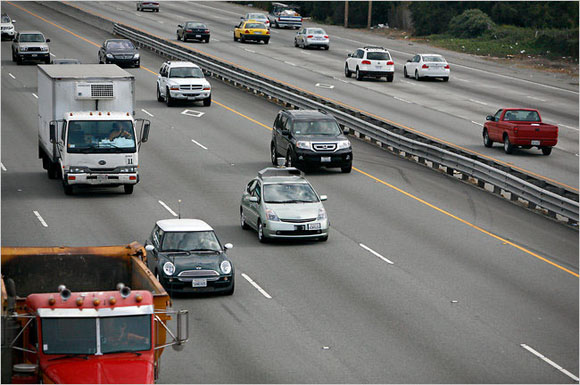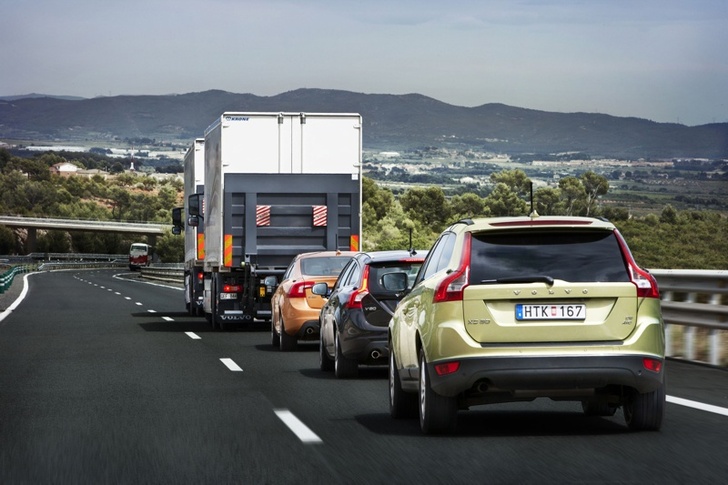Cars

A Google self-driving car on a highway
.The automation of car (and other road vehicles) driving is becoming a reality, though not ready for generalization. The evolution of this kind of beings is interesting since it shows :
- the high number of functionalities involved for each car,
- the high flow of communication among vehicles, going along with group actions (platoons)
- the high flow of communication with global informational and regulation instances
- the considerable consequences for transportation economy, psychology and sociology, and society in general.
We mix here present facts and logical/probable extensions in the future.
Car internal functionalities
- The car drives itself, according to aims indicated by the owner, using a lot of sensors, including vision of natural images, local markings and GPS indications. It parks itself once the destination reached.
- It optimises the itinerary, from different possible standpoints : cost (gas, tolls) , ecology (pollution), travel duration. It the transportation request is given in advance, it is able to optimize the starting time. It can also use the time from parking to boarding place to adjust air conditioning
- It knows the meteorological data, and can adapt its driving behavior, internal air conditioning.
- If there is a driver, it assists it, to ease his work, specially in difficult or risky times (curves, reverse in parking space, urgent braking). The car knows the driver (legal, mental, health profile, driving experience) and its present state (alertness, possible lack of sleep), understands their commands if not their intentions, and adapt to that. Possibly with specific sensors (for alertness) and time recording (to demand rest times).
- It knows where it is and remembers its past moves. It has a kind of "black box" for all the data, including formal commands, sound, pictures videos, which will be useful in case of accident of crash.
- It knows its own technological state, gas stock, battery load level, oil and windscreen washer levels. It predicts the necessary refills. It detects failures, organizes repair and preventive maintenance.
- It knows its legal status : owner, maker, insurance, maintenance contracts, legal obligations (for instance, periodical technical controls), and of course, traffic rules. It can manage its leasing contract, and give pertinent information both the leaser, the user, etc. In cas of accident, it will contribute in the responsibility of the driver, owner, other beings and itself.
Some references :
- Automotive autonomy. Sefl driving cars are inching closer to the assembly line, thanks to promising new projects from Google and the European Union. 3pages by Alex Wright in CACM july 2011.
- How do you know a vehicle has seen you ? Technology Review (MIT)
- Driverless cars ready to hit our roads. NewScientist 4/2012.
- A more skepical approach is reflected in an article of the New York Times (1/24/2012).
More ancient references :
- Interview of Michel Parent in Asti Hebdo 3/17/2003.
- Intelligent vehicle technologies, Ljubo Vlacic, Michel Parent et Fumio Harashima eds. Butterworth/Heinemann 2001
Communication among vehicles

A platoon of vehicles (European project Sartre )
Communication between vehicles (mainly, the nearby ones), uses two kind of ways :
- sensors to perceive the position and moves of other objects, still or mobile, without coopertation of these objects,
- network links betwenn control systems of the other vehicles.
Cooperation may foster ride sharing. It may also take to grouping in "platoons", since each vehicle can use in microseconds information given by the front vehicle. Then the security distance implied by the latencies in human nervous system are no longer necessary. The platoon operation would be useful
. to make better use of the roads, mostly at rush hours,
- to reduce comsumption due to aerodynamic effects of closeness.
Cooperation could be extended to other types of transportation, specially rail, to extend the piggy backing (Wikipedia. "ferroutage" in French).
References :
<
Progress and Challenges in Intelligent Vehicle Area Networks. by Miad Faezipour, Mehrad Nourani, Adnan Saeed and Saatesh Addepalli. Communications of the ACM, february 2012.
< Communication Technologies for Vehicles by Marion Berbineau, Magnus Jonsson, Jean-Marie Bonnin, Soumaya Cherkaoui, Marina Aguado, Cristina Rico-Garcia, Hassan Ghannoum, Rashid Mehmood, Alexey Vine. LNCS 7865. Springer 2013.
Communication with global beings
The vehicle communicates with global systems and authorities (road information systems, traffic prediction, police etc.). With connected cars, these agents can :
- immediately detect problems,
- optimize global flows,
- build statistics for infrastructure maintenance and enhancement, and give data to corporations operating on this market (manufacturers, insurers...).
More technically
- It communicates with information servers. Possibly, a lot of functions, all those which do not require instant action, can be subcontracted to servers (possibly with redundancy between local and remote functions). For instance the whole recording of data about the car.
- The material organization of the car may differ considerably from what we know today, since there is no longer need of fully developpend windscreen, dashboard, wheel and pedals... provided there remains a minimal interface to drive the car in case of breakdown.
More holistically
- Finally, the individual car can be seen more as an element it a global swarm of vehicles more than an autonomous agent. Specific requests by individuals are not answered to directly, but throught global evaluation and decision making at a global level. The cooperation processes and structures may be hierachical or not (with models like neural networks, cellular automata and even evolutionary processes).
Consequences for economy, psychology and sociology
- Reduction of pollution, better use of the infrastructures
- Zero-accident car transportation
- Million of hours spent driving rendred free.
- Individual use of cars no longer
restricted to licensed and healthy adults.
- Automata take the seat of billions of drivers, professional or amateur.
- Industry and society will be deeply changed.
To conclude. We have here a category of beings, the automaton driving a vehicle, which comes in competition with its human counterpart. It will, with nearly all certainty, win the contest for safety and performance reasons. The consequences for mankind are considerable.. Vehicle driving is the job of millions of people, and an important part of the lives of billions. Besides, driving (we say also "riding") is associated with social values with roots back to the middle-ages knights. Then the transition will be a major issue. It is presently hidden by the car industry and the political circles, then in the mass media. For how long ? Probably two decades at most.
References
http://www.bbc.co.uk/news/technology-21462360
http://www.vtnews.vt.edu/articles/2012/12/120412-vtti-zohdyrakhabestpaper.html. Automatic control at intersections.
http://www.newscientist.com/article/dn22297-lanekeeping-app-makes-any-car-smarter.html
http://www.technologyreview.com/blog/energy/27797/ (communication véhicule/piétons)
http://www.newscientist.com/article/mg21328585.300-driverless-cars-ready-to-hit-our-roads.html
http://www.computerworld.com/s/article/9232781/Intel_readies_for_programmable_smart_cars
http://www.washingtonpost.com/business/technology/web-connected-cars-bring-privacy-concerns/2013/03/05/d935d990-80ea-11e2-a350-49866afab584_story.html
Sur voitrures automatiques http://www.nytimes.com/2012/01/24/technology/googles-autonomous-vehicles-draw-skepticism-at-legal-symposium.html?_r=1
http://www.computerworld.com/s/article/9231707/Self_driving_cars_a_reality_for_39_ordinary_people_39_within_5_years_says_Google_39_s_Sergey_BrinMachines